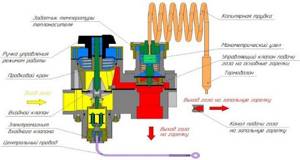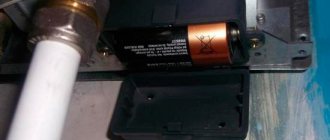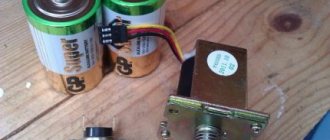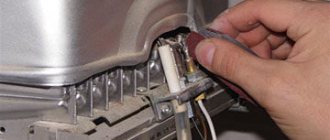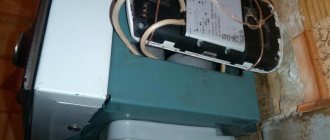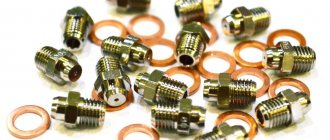ATTENTION! Maintenance operations and repairs of geysers associated with dismantling its gas or water communications must be carried out by qualified craftsmen. Self-repair can have the opposite effect before purchasing a new device.
Error E1 - no flame
The ignition clicks for about a minute, the burner does not ignite. The electronic control unit does not see the presence of a flame and the column goes into emergency mode.
Reason #1. Presence of air in communications. If the column is idle for a long time, or after its installation, the pilot burner will operate only after air has been removed. The system should be purged by constantly turning on the column. Since ignition lasts no more than a minute, after completion you should reopen the water tap until ignition occurs.
Reason #2. There is no gas in the cylinders or the tap on the downstream side of the dispenser is closed. Open the shut-off valve completely. Check LPG gas cylinders. Replace them if necessary.
Reason #3. There is no contact between the block and the flame sensor. The contacts coming out of the electronic unit should be serviced, if necessary, cleaned, pressed for a good connection, and worn ones should be replaced.
Reason #4. Flame sensor outside the flame zone. Adjust the position of the flame sensor so that its electrode is in the gas combustion zone. Make sure that the electrode does not touch other metal components. Clean the electrode from carbon deposits.
Reason #5. The gap between the spark plug and the igniter is broken. Due to constant heating and cooling, the ignition burner nozzle is deformed, which increases the gap to the spark plug. Once every two years, or during regulated maintenance, the gap should be adjusted to 4...5 mm.
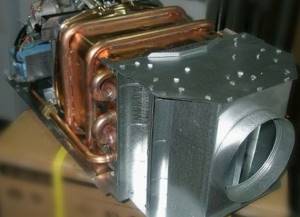
Most common faults
The following problems when using a water heater indicate malfunctions of certain components:
- the burner does not light;
- the burner does not go out;
- the column turns off spontaneously;
- insufficient water heating;
- overheating of water.
Let's look at what this looks like in practice. You turn on the faucet in the kitchen or bathroom, expecting hot water to come out. But contrary to expectations, the burner does not light. Another situation: the column starts to work normally, but soon turns off, although you did not turn off the water tap.
They wanted to wash their hands and almost got burned because boiling water was running from the tap. Or, on the contrary: you are about to take a shower, but the water is barely warm. A very unpleasant moment: you turn off the water, but the burner continues to burn.
The problems listed above can have completely different causes. Sometimes they lie on the surface, as is the case with dead batteries. But often you have to perform one complex operation after another to get to the bottom of it.
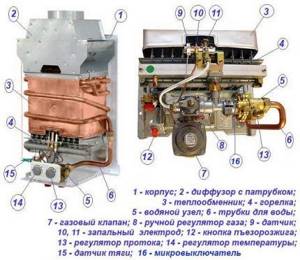
Older models, such as Neva-3802, use manually controlled piezo ignition; to start it you need to press two buttons simultaneously
The work of home craftsmen is made difficult by the lack of experience, professional tools and a thorough understanding of the principles of operation of a gas water heater. Therefore, when starting diagnostics and repairs, it is worth weighing all the pros and cons, guided by the principle “do no harm.”
Problems due to lack of power supply
Neva water heaters are fueled by gas, but they cannot operate without electricity. The control unit, glow plug, solenoid valve and other components of the device require a stable power supply. It is powered by two LR20 alkaline batteries, located in a separate, easily accessible compartment.
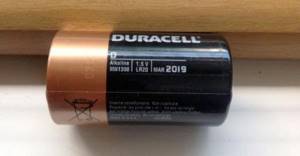
For uninterrupted operation of a gas water heater with electric ignition, it is advisable to have at least two LR20 or CR20 batteries in stock
If there is no electricity, when you turn on the water tap, the spark discharge will not occur or will be weak and the column will not turn on.
Lack of power supply can be caused by discharged batteries, oxidation of the battery compartment contacts, or a break in the electrical circuit.
If the batteries are not completely discharged, they can power the display, but they will not have enough power for more energy-intensive operations. Therefore, if you see that the display is working normally and displaying temperature data, still clean the contacts of the battery compartment and replace the batteries with new similar ones or lithium CR20.
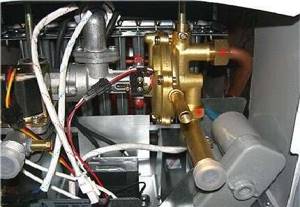
The battery compartment is located at the bottom of the device and is accessible without removing the casing; when installing batteries, be sure to observe the polarity
The battery compartment cover is located at the bottom of the case and is accessible without disassembling the device. That is, you can clean the contacts and replace the batteries yourself. Eliminating the causes of underheating of water.
If the column still does not turn on with new batteries, you need to check for scale in the heat exchanger pipes.
The formation of scale on the internal surfaces of the pipe prevents the normal passage of water, which can lead to the column turning off. Also, a thick deposit of magnesium and calcium salts significantly reduces thermal conductivity; the device cannot provide the heating capacity stated in the accompanying documentation, which leads to insufficient heating of the water.

To remove scale, use regular citric acid diluted with warm water, the amount of solution should correspond to the volume of the heat exchanger, you can also use table vinegar
Let us remind you that the operating instructions indicate that it is necessary to clean the gas water heater and its heat exchanger every 12 months. When the column is used intensively and hard water is used, scale forms faster, so extraordinary cleaning may be required.
To do this, you will need to remove the casing and remove the heat exchanger. Before disassembling, close the taps on the gas and water inlet pipes. Remove the gas and water adjustment knobs by pulling them towards you. Some models have screws under the handles that can be removed with a screwdriver. Also unscrew the screws that secure the casing to the bracket from below on both sides.
The wires connecting the water temperature sensor and the control unit with the display are disconnected. Remove the casing by pulling it towards you and sliding it up. Looking ahead, we note that after repair, installation of the casing is performed in the reverse order.
So, the casing has been removed and now it is necessary to remove the heat exchanger. Unscrew the plug located under the water unit and drain the remaining water from the heat exchanger. Disconnect the column pipes from the cold and hot water pipes, remove the old gaskets. Unscrew the two screws and remove the metal plate securing the heat exchanger at the top.
Remove the heat exchanger and place it in a container with a hot solution of dishwashing detergent or regular laundry soap. After 15 minutes, use a soft brush to remove soot from the grill and other surfaces. Rinse the grill and other surfaces under a strong stream of water.
To remove scale from pipes, prepare a warm solution of citric acid at the rate of 100 grams per 1 liter of water heated to 40°C. The resulting solution is poured into the heat exchanger pipe and drained after 15 minutes. The pipe is washed with water. If necessary, repeat the procedure.
When installing the heat exchanger in place, the detachable connections are sealed with new gaskets. Do not overtighten the connections so as not to crush the gasket. Otherwise, its compressed edge may end up in the pipe in the path of water flow, which will cause unpleasant noises. Installing skewed gaskets will lead to similar consequences.
Damage to the gas-water unit
If power is provided, the heat exchanger is clean, but the water heater does not turn on, you will have to disassemble the gas-water unit to determine the condition of the membrane and rod.
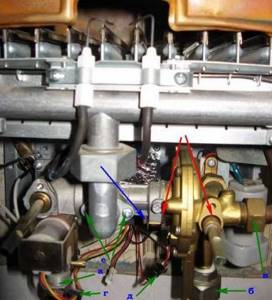
The sequence of dismantling the gas-water unit of the column, indicating detachable connections that require sealing with elastic gaskets to avoid water leaks. The steps are listed in alphabetical order
Let us repeat that during repair work the gas and water supply taps must be closed. The water unit is dismantled together with the gas unit.
The gas and water supplies are turned off, the nut of the heat exchanger pipe is unscrewed, the wires connecting the solenoid valve to the control unit and the microswitch wires are disconnected.
Unscrew the screws connecting the gas-water unit and the burner manifold pipe. Now this assembly can be removed and placed on the table for further disassembly.
After unscrewing several screws, the gas block is separated from the water block and set aside. Then they work only with the water block. Unscrew the screws located around the perimeter. The block is divided into two parts, between which the membrane is located.
The membrane is removed and inspected. Most often, it is because of its stretching or breakthroughs that it is not possible to turn on the column. During reassembly, the new membrane is placed in the standard socket. The rod is installed in such a way as to ensure its translational movement without jamming.
When does a solenoid valve need to be replaced?
If the solenoid valve fails, gas does not enter the system and the column does not turn on. The valve is removed from the device, but is not disconnected from the control unit.
By simulating the supply of water to the system by moving the microswitch pusher, the ability of the valve to retract and hold the rod is determined, opening the passage of gas to the burner. If the valve does not work, replace it. To do this, disconnect the wires, remove the water-gas unit, unscrew the fastening screws, remove the old valve and install a new one in its place.
Incorrect burner operation
Displacement of the spark plug electrode or the formation of carbon deposits on it leads to the absence or weakening of the ignition spark and, as a result, to the failure of the column to turn on. Also, due to problems with the spark plug electrode, an increase in gas concentration in the combustion chamber is possible. For this reason, ignition is accompanied by a loud bang.

The arrows point to the most problematic areas of the water heater burner, including spark plug electrodes that require cleaning from soot, as well as electrical wire connectors
It is enough to clean the electrode with sandpaper and return it to its normal place so that the spark “works” and the extraneous noise disappears.
When the burner becomes clogged, its flame weakens and begins to smoke. As a result, the water does not heat up to the intended temperature. Before cleaning, remove the burner by disconnecting the wires of the ionization sensor and spark plug, unscrew the manifold pipe nut and two screws, remove the manifold, unscrew two more screws and disconnect the burner block.
Use a brush to clean the surfaces of the parts. Use a brush of a suitable size to clean the internal channels. After removing the dust, wash the parts with dishwashing detergent, rinse and, after drying, put them back in place. The flame of a clean, working burner is blue.
Sensors and electrical circuit or why the burner goes out
As was said in the chapter about the design of the water heater, the security system includes three sensors that are connected in series into a single electrical circuit.
It is enough for one of them to fail to open the electrical circuit and turn off the column.
The ionization sensor installed on the burner, as well as the glow plug, is equipped with an electrode that can become dirty or change its position, and then not “see” the flame. With such a malfunction, the water heater starts working normally, but after a few minutes the burner goes out because the solenoid valve shuts off the gas.
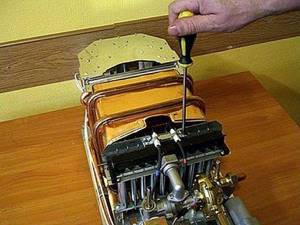
When disassembling the burner, it is necessary to unscrew the screws securing the clamping plate, which holds the flame sensor and spark plugs
Cleaning the flame sensor electrode is also done with sandpaper, after which it is installed in such a way as to “see” the flame.
The gas water heater with the Neva logo also goes out due to an improperly equipped chimney or its clogging. If the draft is poor, the removal of combustion products becomes impossible. To prevent the accumulation of harmful substances in the room, the corresponding sensor is triggered and the column turns off.
When the water temperature reaches 90 degrees, the overheating sensor reacts and the column immediately stops working. The reason usually lies in incorrect adjustment of the gas and water supply, or in insufficient pressure in the water supply network.
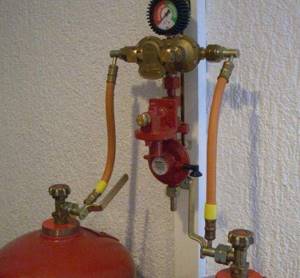
The model range includes devices operating on liquefied gas. The gas cylinder is connected to the water heater through a reducer, which can also cause malfunctions
Sometimes it is enough to turn the gas control knob towards the minimum or increase the water flow so that the dispenser stops turning off. You also need to set the “winter/summer” knob to the appropriate position in time.
The functionality of the gas water heater sensors and the integrity of the electrical circuit are checked using a multimeter. If the sensors are working properly, the electrical resistance is close to zero. A breakdown of the overheating sensor is also indicated by an error code - the letters “EE” are displayed on the display instead of the usual water temperature indicators.
If there is no device for measuring resistance, testing is carried out by installing jumpers to close the circuit and turn on the column. If the column works normally with this connection, it means that the sensor being tested is faulty and needs to be replaced.
It must be remembered that installing jumpers is only a diagnostic method, and not a repair method. It is prohibited to use a column with jumpers instead of sensors.
Error E7 - lack of gas
The speaker goes out after switching on. Unsuccessful ignition attempt. Process: the igniter lights up, then the main burner, then everything goes out and the process repeats again.
Reason #1. Low gas pressure. Open the gas valve on the downstream side of the column. Invite a specialist to your home to measure the gas pressure in the system and further configure the column. You should also blow out and clean the gas filter.
Reason #2. The flame ionization sensor is not located in the fire zone of the main burner. Adjust the sensor. Install the electrode so that the fire of the main burner washes on both sides. It is possible that carbon deposits have formed on the sensor, which makes heating weak - clean and adjust the sensor.
Reason #3. The mechanism in the water unit is stuck. Increased deposition of salts on moving mechanisms leads to jamming and stopping. A stuck rod of the water unit leads to a permanent short circuit of the flow sensor. In this case, you should dismantle the water part and carry out preventive work: lubricate the rod, replace rubber gaskets.
Types of columns
The energy source of the geyser is gas
When choosing equipment, first of all you should pay attention to the technical characteristics, price and quality of the device. According to technical characteristics, geysers are divided into:
- By power. The volume of heated water depends on it.
- By the type of chimney.
- By type of ignition.
- By size.
- According to security conditions.
- For additional options.
The Neva company is a domestic manufacturer. They produce quality products at reasonable prices. On the Internet you can find a lot of positive reviews about this company. The assembly and components of the device are performed at a high level. The Neva company provides a 12-year warranty on equipment. You will be able to service your geyser under warranty for 2 years.
Error E8 - no traction
The column turns off after 2..5 minutes of operation. Restarting becomes possible only after cooling down - 2..3 minutes.
Reason #1. Lack of draft in the chimney. Clean the chimney.
Reason #2. Soot on the heat exchanger. Increased accumulation of soot on the heat exchanger, which prevents the passage of carbon monoxide into the chimney. To resolve the problem, the column must be serviced.
Reason #3. The traction sensor is faulty. The traction sensor works to break. Over time, the sensor becomes very sensitive to vibrations and may turn off the column during heating. Therefore, if this error occurs, the sensor will be checked for functionality.
Design and operating principle of PGV "Neva"
The series of instantaneous gas water heaters (PGW) of the Neva brand includes many models and modifications. Today, the most popular are NEVA-4510M, NEVA-4511, NEVA 4513M with electric ignition.
They are manufactured at the factories of the domestic company BaltGaz Group in accordance with GOST 31856-2012 and include:
- metal case;
- gas path;
- water circuit;
- burner;
- combustion path;
- security system;
- control system;
- adjustment block.
The listed nodes consist of many elements, some of which are shown in the diagram below.

Main positions: 6, 7, 8 – pipes for water supply, hot water supply and gas pipes; 12 – water block; 13 – tap for adjusting water flow; 15 – microswitch; 16 – control unit, 17 – gas unit; 18 – gas flow adjustment valve; 19 – electromagnetic gas valve; 20 – burner; 23 – candle; 24 – flame sensor; 25 – heat exchanger; 29 and 32 – overheating and draft sensors; 34 ¬ battery compartment
The water circuit begins with a pipe connected to the cold water pipeline and is pumped into the hot water supply pipe. This includes the water block, which plays a key role in electric ignition. It consists of a lower and upper chamber, between which there is an elastic membrane.
When the tap is turned on, a stream of cold water rushes to the heat exchanger, but along the way it passes through the lower chamber and completely fills it. Under water pressure, the membrane of the gas column bends and presses on the poppet valve of the rod located in the upper chamber.
The water block rod extends through the hole and acts on the coaxially located gas block rod. This, in turn, acts on a mechanical gas valve, the plate of which moves back and allows gas to pass through, instantly filling the burner manifold.
At the same time, when the rod moves, the microswitch plate is triggered, closing the electrical circuit.
Electrical current comes from batteries located in the battery compartment and powers the control unit, which supplies electrical voltage to the glow plug and opens the solenoid valve. Spark discharges occur between the burner nozzle and the spark plug electrode, igniting the burner.
The heat produced by burning gas is transferred to a heat exchanger pipe through which water flows. As a result, a few minutes after turning on the tap, hot water flows out of it. When the tap is turned off, the reverse processes occur and the burner goes out.
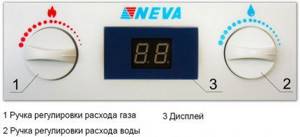
On the front side of the cladding there are adjustment knobs, as well as a display that displays the water temperature at the water intake point
Gas is one of the cleanest types of fuel in an environmental sense, but its combustion also releases carbon dioxide, water vapor, and nitrogen. They are removed from the combustion chamber to the outside through the gas exhaust pipe and chimney of the gas boiler. Removal of combustion products is possible only if there is proper draft in the chimney.
To control the operation of the column and ensure its safe operation, the following sensors are included in the design:
- presence of flame;
- presence of traction;
- water temperature.
Thanks to these components, gas flows to the burner only when the tap is turned on and there is water in the water supply. If the burner goes out for any reason, the gas supply is immediately stopped.
The automatic shutdown of the water heater is caused by the lack of proper draft in the chimney and an increase in the water temperature at the water intake point to 90°C. If the pressure in the water circuit reaches a critical value of 1000 kPa, the emergency valve is activated and excess water is drained.
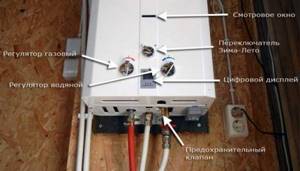
Modern models are equipped not only with knobs for adjusting water and gas flow, but also with a “Winter/Summer” knob, which is set to the desired position depending on the time of year
Now that you have become familiar with the structure and design of the Neva gas water heater, you can move on to the next chapter of the article, in which we will list the most common malfunctions, the causes of their occurrence and solutions.
Please note that the manufacturer recommends that in order to carry out maintenance and repair work related to disassembling the gas-water unit, you call the employees of the service center, with which an agreement has been concluded for the supply of gaseous fuel and equipment maintenance.
Error H1 - insufficient heating
The column does not heat the water to the set temperature.
Reason #1. The temperature is set to high and the pressure is high. The column cannot heat the amount of water that passes through the column. Reduce pressure.
Reason #2 . The burner is clogged with dust. If you notice that the gas is burning orange and the flame is sluggish and elongated, then it’s time to clean the burner. If you neglect cleaning, this error will appear constantly. The column efficiency will decrease by half. A lot of soot will appear.
|
|
Malfunctions of the Neva gas water heater: design, errors, do-it-yourself repairs
If you are faced with a water heater breakdown, do not panic - our article will help. Malfunctions of the Neva gas water heater can occur for various reasons, but typical ones can be identified. We'll tell you how to repair Neva models at home.

Important! If your equipment is under warranty, do not disassemble it yourself, otherwise you will lose free service.
Tips for preventing problems at geysers
For successful, safe and long-term operation of Neva speakers, you must adhere to the manufacturer’s instructions, as well as a number of simple rules, among which the most important point is the timely replacement of filters.
Note! In addition, the chamber should be cleaned and the igniters inspected from time to time. Problems that can be prevented, namely problems with clogged heat exchanger tubes, as well as membrane wear, can be solved by installing additional water filters at the inlet.
If you identify any difficulties or questions in the operation and setup of geysers, it is advisable to immediately contact qualified technicians who will quickly and accurately diagnose the breakdown and set up the device. However, there are errors that you can eliminate yourself. All these questions are answered in this article.
The Neva Transit VPG 10e automatic gas water heater is in operation. Please explain why she started heating the water poorly? What do you recommend I do to fix the problem?
First of all, contamination in the heat exchanger. The accumulation of plaque in the heat exchanger partitions limits the required water heating, and the water heater begins to heat the water insufficiently. In this case, you need to clean the heat exchanger. Secondly, systematic overheating of the heat exchanger. This occurs due to improper operation of the water heater. Elevated temperatures lead to the formation of scale, which impairs the heating of the liquid. In this case, replace the heat exchanger.
We have a gas water heater from the same company in our private house. It worked for about five years, after which a leak formed from the heat exchanger. The repairs did nothing, and after three months I purchased a new water heater. The installer recommended maintenance and cleaning every year. I cleaned it and did that. As a result, this column worked for 4 years, but the problem was the same - a leak in the heat exchanger. Why might this be?
The water is probably of poor quality, causing the heat exchangers to leak.
A model of this brand is connected to a private house. Can anyone explain why the water sometimes gets too hot? What is the problem?
Apparently the regulators are installed incorrectly. We need to set them up for the summer. Use the gas flow adjustment knob to minimize the gas on the burner device, and then increase the water flow on the device.
There was a malfunction at the Neva Transit turbo flow-through gas water heater. The wick lights up, I hold it in this position for about 4 minutes. After that I put it into working condition, but the unit goes out. Why is this happening?
You need to remove the housing, remove the pipe through which gas is supplied to the igniter, and clean it. In theory, this procedure should be carried out annually, especially at the end of summer, since dust gets into this tube through open windows.
Help us understand what is wrong when the device sometimes performs the heating process unsatisfactorily. What are the solutions?
Most likely, the flame on the burner is weak, which indicates a malfunction of the membrane, and the pressure of the rod on the gas valve is too weak. It is recommended to disconnect the water block from the gas fittings. After this, remove the cover from the water block and check the membrane for defects, and if it is unsuitable, replace it.
Two years ago we connected a gas water heater of this brand to heat a private house. Recently, a problem has emerged at the moment of ignition. When there is a request for hot water, the igniter is ignited. It lights up and quickly goes out, and then the water heater starts again. And in this rhythm there are two or three attempts. Subsequently, the functionality of the unit is normalized. I just don’t understand why the pilot flame doesn’t ignite the main burner? What can happen? Now the water heater works as follows. A spark appears, which ignites the igniter. After this, the spark disappears, the pilot light burns for a few seconds and goes out. The device sparks again, the igniter lights up, the spark disappears, and after a short pause the main burner lights up.
Presumably, there is a problem with the ionization sensor. First you need to inspect it. Although, it is more advisable to replace it with a new one, but if this fails, you need to clean this one with sandpaper. Also clean the burner using a metal brush. After these measures, it is important to make sure that the burner flame is not yellow, but blue. In addition, the fire needs to reach the ionization sensor.
We installed and connected the Neva Transit VPG 12e hot water water heater on batteries six months ago. But when winter comes, there is often a problem associated with low gas capacity; moreover, the gas supplied is not clean. Help me fix the problem?
There is a screw at the bottom of the unit. When the burner is turned on, you need to turn it to the left and set the correct fire level. In summer, turn it back. If such a procedure does not help, then the pressure in the system is indeed weak.
Who can install the BaltGaz geyser
Only specially trained specialists can install speakers. The specialist must have permission to work with indoor gas equipment. Such specialists undergo annual examinations and confirm their qualifications.
Also, the technician who performs the installation for you must be on the staff of an organization that has an SRO permit for certain types of work. Type of work allowing installation of gas equipment: 19.8 Installation and dismantling of gas equipment for consumers using natural and liquefied gas.
The installation organization must also coordinate its documents with the manufacturer. If the documents are not agreed upon, warranty service may be denied.
If the installation is carried out by a private owner himself, then the manufacturer does not provide warranty service. We recommend that you contact our specialists for the installation of geysers, then you will receive warranty service for 5 years, and you will also have peace of mind for yourself and your family that the gas water heater is installed correctly.
Device and principle of operation
In many cases, fixing a problem with automatic ignition or with other components of the device is quite easy, and you don’t even have to seek the help of professionals. However, in order to understand why the Neva geyser does not work well, it is worth studying its structure.
The system includes:
- housings (for wall-mounted models - supplemented with mounting loops);
- heat exchangers made of copper;
- water circulation units;
- burner complexes;
- concentrators of gaseous combustion products (diffusers);
- pipes for connection with the chimney;
- water supply tubes;
- igniter electrode;
- faucet regulating the passage of water;
- segment for batteries;
- a system that regulates heating power and fuel consumption;
- ionization fire indicator.

The typical method of operation of a gas burner is very simple. As soon as the water tap supplying hot water is opened, the pressure of the jet begins to act on the membrane of the control unit. Under its pressure, the rod moves, which opens the gas valve, and the contacts of the switching device close. Through the electrical circuit, current from the batteries begins to flow to the controller. The electronics sends two signals at once: one by one, the valve opens, allowing gas to pass through; the second, an electric spark appears on special electrodes.
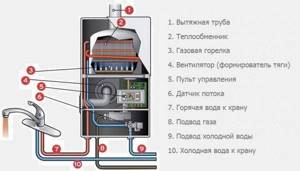
As soon as the fire detector detects characteristic ionization, it sends a signal to the central automation. It stops initiating the spark. Heating is carried out in standard operating mode. The mixer valve is closed. The membrane immediately moves back, and the gas passage valve closes.
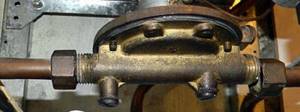
At this moment, the limit switch is activated, stopping the flow of current to the controller. Without power supply, the electromagnet remains. Since no gas enters the burner, it should go out immediately. The valve is connected to the same circuit as the draft meter. When this draft disappears or is weakened excessively, the heated sensor opens the circuit, thereby stopping the power supply to the electromagnet and the passage of gas to the burner.
